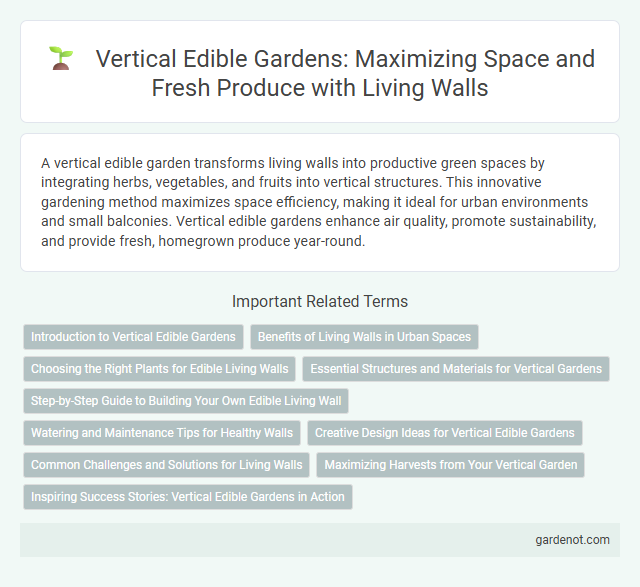A vertical edible garden transforms living walls into productive green spaces by integrating herbs, vegetables, and fruits into vertical structures. This innovative gardening method maximizes space efficiency, making it ideal for urban environments and small balconies. Vertical edible gardens enhance air quality, promote sustainability, and provide fresh, homegrown produce year-round.
Introduction to Vertical Edible Gardens
Vertical edible gardens maximize limited space by growing fruits, vegetables, and herbs on walls or vertical structures. These innovative systems improve air quality, enhance aesthetics, and provide homegrown fresh produce year-round. Utilizing vertical gardening techniques increases crop yield per square foot, making it ideal for urban environments.
Benefits of Living Walls in Urban Spaces
Living walls transform urban spaces by improving air quality through natural filtration and reducing heat island effects, promoting healthier environments. Vertical edible gardens maximize limited space, providing fresh, locally grown produce that enhances food security and supports sustainable living. These green installations also boost urban biodiversity, creating habitats for pollinators and contributing to ecosystem resilience.
Choosing the Right Plants for Edible Living Walls
Selecting the right plants for a vertical edible garden involves prioritizing compact, fast-growing species that thrive in limited soil and require minimal maintenance. Herbs like basil, mint, and thyme, along with leafy greens such as lettuce, spinach, and arugula, perform exceptionally well in living walls. Incorporating dwarf fruiting plants like cherry tomatoes or strawberries enhances both productivity and aesthetics in vertical edible gardens.
Essential Structures and Materials for Vertical Gardens
Vertical edible gardens rely on essential structures such as sturdy frames made from weather-resistant materials like galvanized steel or treated wood, ensuring durability and support for plant growth. Growing mediums typically include lightweight soil mixes or hydroponic systems to optimize nutrient delivery and water retention. Irrigation components like drip lines or wick systems are crucial for maintaining consistent moisture levels and promoting healthy edible plants in the vertical setup.
Step-by-Step Guide to Building Your Own Edible Living Wall
Create a vertical edible garden by selecting a sturdy wall with sufficient sunlight exposure, then install a durable frame or modular planting system designed for vertical planting. Choose nutrient-rich soil mixtures and drought-resistant edible plants like herbs, leafy greens, and strawberries to ensure healthy growth. Regularly water, fertilize, and prune the plants while monitoring for pests to maintain a thriving, space-efficient edible living wall.
Watering and Maintenance Tips for Healthy Walls
Vertical edible gardens thrive with consistent watering methods such as drip irrigation or self-watering systems to ensure even moisture distribution. Regular pruning and harvesting stimulate plant growth and prevent overcrowding, enhancing air circulation on the living wall. Monitoring for pests and nutrient deficiencies with organic fertilizers supports vibrant, healthy edible plants.
Creative Design Ideas for Vertical Edible Gardens
Vertical edible gardens transform limited spaces into lush, productive green walls by utilizing modular planting systems and tiered containers. Incorporating herbs, leafy greens, and compact fruiting plants, these designs maximize sunlight exposure and ease of harvest through clever placement and irrigation techniques. Creative ideas include integrating recycled materials like pallets and using living walls as natural kitchen decor to blend aesthetics with functionality.
Common Challenges and Solutions for Living Walls
Vertical edible gardens often face challenges such as water retention, nutrient delivery, and pest management. Implementing efficient irrigation systems like drip lines and using nutrient-rich soil mixtures help maintain plant health and growth. Integrating companion planting and regular monitoring can effectively control pests while promoting biodiversity in living walls.
Maximizing Harvests from Your Vertical Garden
Maximizing harvests from your vertical edible garden involves selecting high-yield crops like cherry tomatoes, herbs, and leafy greens that thrive in compact spaces. Employing efficient watering systems such as drip irrigation ensures consistent moisture, promoting healthy growth and abundant produce. Regular pruning and rotating crops in your vertical garden optimize sunlight exposure and nutrient distribution, resulting in continuous, bountiful harvests.
Inspiring Success Stories: Vertical Edible Gardens in Action
Vertical edible gardens transform urban spaces into lush, productive environments, exemplified by projects like New York's Brooklyn Grange, which produces over 50,000 pounds of organic vegetables annually on rooftops. In Singapore, the Sky Greens system innovatively uses vertical farming techniques to supply affordable, fresh produce to local communities, significantly reducing food miles. These inspiring success stories showcase how vertical edible gardens boost food security, maximize space efficiency, and promote sustainable urban agriculture worldwide.
Vertical edible garden Infographic

 gardenot.com
gardenot.com